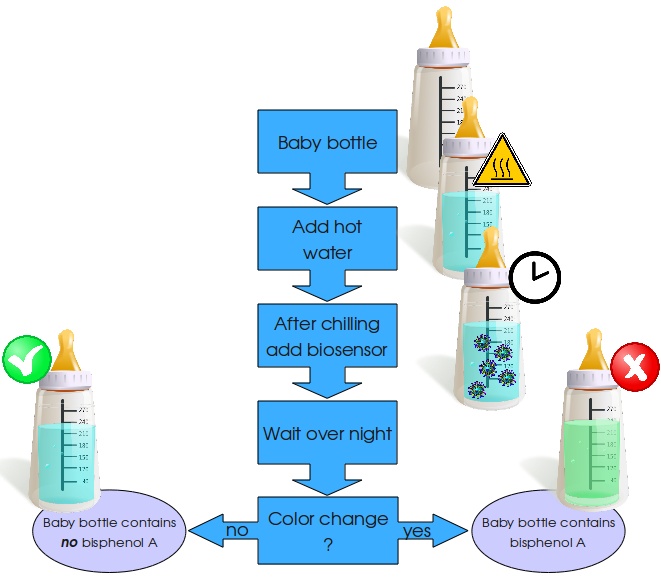Team:Bielefeld-Germany/Project/Appoach
From 2011.igem.org


Contents |
From the idea to a rough plan
After finding all members for our team in January 2011 we began thinking about an idea for an iGEM project. We had many different ideas, from carbondioxide eating E. coli to a biosensor for dioxines. But in the beginning of February we noticed an [http://www.spiegel.de/wissenschaft/mensch/0,1518,745019,00.html online article] about the ban of the endocrine disruptor bisphenol A (BPA) in the European Union for the production of baby bottles. We thought that if it would be possible to detect BPA at home using a test that everybody could use, all parents on this world would have one concern less. So we decided to build a BPA biosensor. To ensure an everyday applicability this biosensor needed to be cell-free, non-toxic and easy to handle.
Concretizing the plans of our device
Talking about an approach for this cell-free biosensor, one of our team members said that it would be great to have a surface which could be functionalized, just like the team from Slovenia did 2010 with DNA - but two-dimensional instead of one-dimensional. We wanted to go further in this direction and did literature research. This led us to a species of proteins that forms periodic two-dimensional structures on their own in a so called self-assembly: the crystalline bacterial surface layers (abbreviated S-layers). These proteins became our system of choice: usable as a nanobiotechnological scaffold for a lot of different cell-free applications, providing S-layer BioBricks in an assembly standard for fusion proteins which are supposed to allow future iGEM teams and synthetic biologists an easy arrangement of their nanobiotechnological systems of choice. Our idea of do it yourself nanobiotechnology was born.
Development of different subprojects
Our knowledge of the current state of S-layer applications grew. Afterwards, we needed a way to functionalize a S-layer surface in order to use it as a BPA biosensor. While searching the Partsregistry we found BioBricks for BPA degradation in Freiburg assembly standard. These BioBricks became the starting point of a BPA detecting enzymatic reaction. In this BPA degradation reaction NADH is converted into NAD+. By a sensitive and specific detection of NAD+, an indirect analysis of BPA is possible. Consequently, we divided our project in three subprojects:
- Isolation of S-layer genes from different organisms and establishment of methods for producing, purifying and immobilizing the related gene products.
- Enabling E. coli to degrade BPA and establish an enzymatic cell-free BPA degradation.
- Detection of NAD+ with a high sensitivity and specificity.
For further information about the current state of each subproject take a look at the overview description and for more background information look at the S-layer, bisphenol A and NAD+ detection pages.
Our aims
Primarily, we want to establish methods for the usage of S-layer BioBricks as molecular building blocks for do it yourself nanobiotechnology. We want to provide this system, which is expandable to many other applications and therefore a great example of the principles of creating and using BioBricks and the possibilities of synthetic biology, to the scientific community. But our other subprojects are expandable to other applications, too, showing another principle of engineering: engines are built modular - no matter how small they are. The enzymatic, specific and sensitive NAD+ detection can be used in many other biosensors in which coupled NADH- or NAD+-dependent enzyme reactions are used and the bisphenol A (BPA) degradation BioBricks can further be used in bioremediation approaches.
The final product
After showing the functionality of all our subprojects, they are combined to a cell-free bisphenol A biosensor immobilized on small beads. This biosensor will have many advantages compared to other analytical tests:
- no use of GMOs (genetically modified organisms) in final test enhances biosecurity compared to cell-based biosensors
- no use of toxic substances or expensive machines and chemicals compared to chemical analysis
- higher durability, easier use and reusable compared to enzymatic tests
- easy to handle and usable for everyone
In this spirit, we also developed a "Beacon Box" which is cheap and easy to build and enhances the limit of detection of our biosensor when not having fluorimeters at one's disposal but one's naked eye.
In the end, our BPA biosensor should be used as showed in the following figure:
One day, when all methods are well-established and the production of the BPA detecting S-layers is cheap enough, a small biosensor with BPA permeable membrane sticks in every food container to show the costumers that their food is free of bisphenol A and save to use.
 "
"

